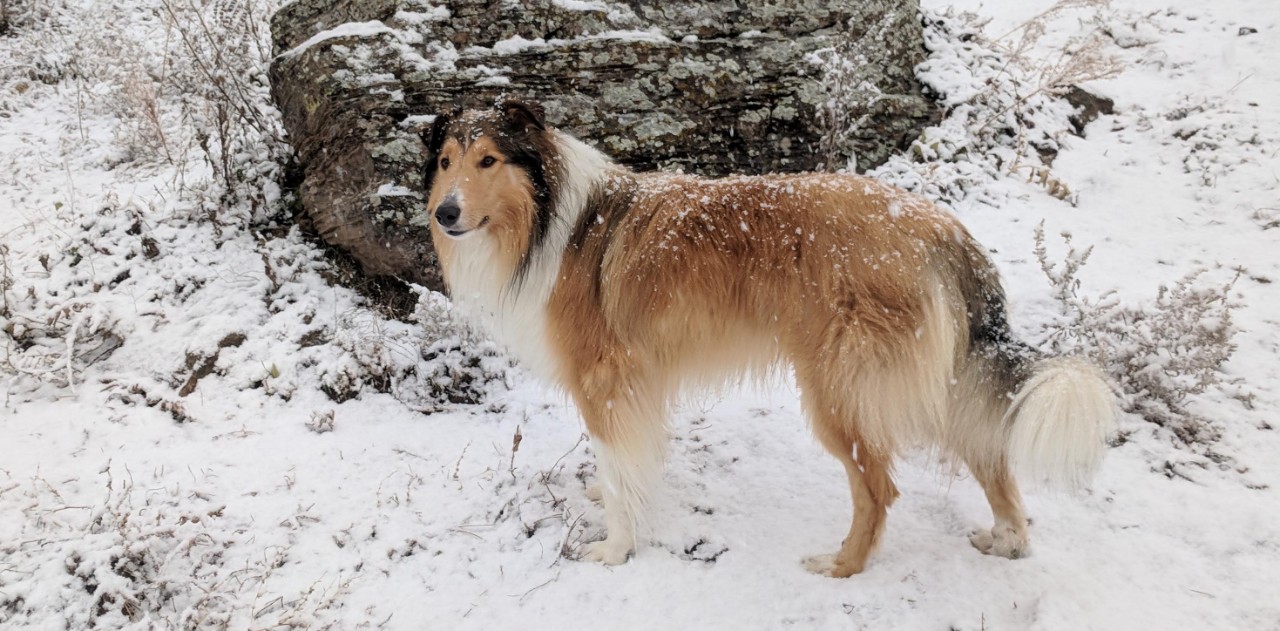
Scottish Collies – preliminary report (SCPS)
UC Davis has been releasing preliminary breed reports once they feel that they have enough dogs to take a very initial look at a breed. Depending on the sample and how well those initial dogs were selected, it is possible they will represent a good snapshot of the breed. Of course, results will change some as more dogs are added.
So, what did UC Davis’ professor emeritus Dr. Niels Pedersen BS, DVM, PhD find in regard to the Scottish Collie in this preliminary analysis? The following article summarizes the full breed report written by Dr. Pedersen. You can find the full report here.
This report is based on testing of 43 carefully chosen Scottish Collies; chosen to represent unrelated bloodlines within the breed. While 43 individuals is not enough for a final analysis, it should give a good initial approximation of the status of the breed.
How inbred is the typical Scottish Collie?
Internal Relatedness, or IR, is one of the measurements released on each individual dog’s report. This is a long used conservation genetics measurement that estimates how inbred a dog is. It ranges from 0 to 1 when a dog is more inbred, and from 0 to -1 when the dog is outbred. An outbred puppy would inherit genetics from its sire that were very different from those it inherited from its dam. An inbred puppy would inherit many of the exact same genetics from both its dam and sire. Being outbred reduces the likelihood of known and unidentified recessive diseases appearing in a breed. The IR values of individual dogs, however, cannot be compared to determine whether they would be good breeding mates.
So, how inbred or outbred are the individuals in the Scottish Collie breed?
From the preliminary report:
The most outbred dog in the population had an IR score of -0.274, while the most inbred dog in the group had an IR score of 0.380, while the mean (average) IR score for the group was -0.011. The IR curve created from this data was also somewhat biphasic, with one group having IR scores < 0.082 and a second group with scores < -0.136 (Fig. 5). This latter group contained at a small proportion of dogs that was more inbred (IR>0.25) than offspring of full sibling parents.
…..
The IR values and IR values adjusted to village dogs (IRVD) (Table 5) can then be graphed and the graphs overlaid (Fig. 5). The IRVD graph, similar to the IR graph, tended to be bimodal with one quarter of the dogs having IRVD scores >0.411 and one half with scores 0.366 (Table 5). Therefore, if this group of dogs were village dogs, more than one-half of them would be considered more inbred than offspring of full sibling parents.
Dr. Niels Pedersen 2019
To translate – the range of inbreeding in the breed is broad and there are inbred and outbred dogs in the breed. However, when adjusted by comparison to a very diverse population, many Scottish Collies are very related and inbred. There is also a section of the population that appears to be especially inbred. Because we can’t necessarily detect where dogs fit into the population without DNA testing and analysis, or how to minimize further inbreeding in already inbred lines, this breed can benefit from predictive software aiding in selection of breeding mates, to insure that future breedings are not too close, risking health as a result.
How much biodiversity exists in the Scottish Collie today?
Dr. Pedersen’s reports look at the data from the VGL canine diversity test in many different ways in order to assess the total amount of biodiversity within a breed. All of these measures together give us a detailed overall picture of the state of the breed and as a result we can make informed decisions on breed management.
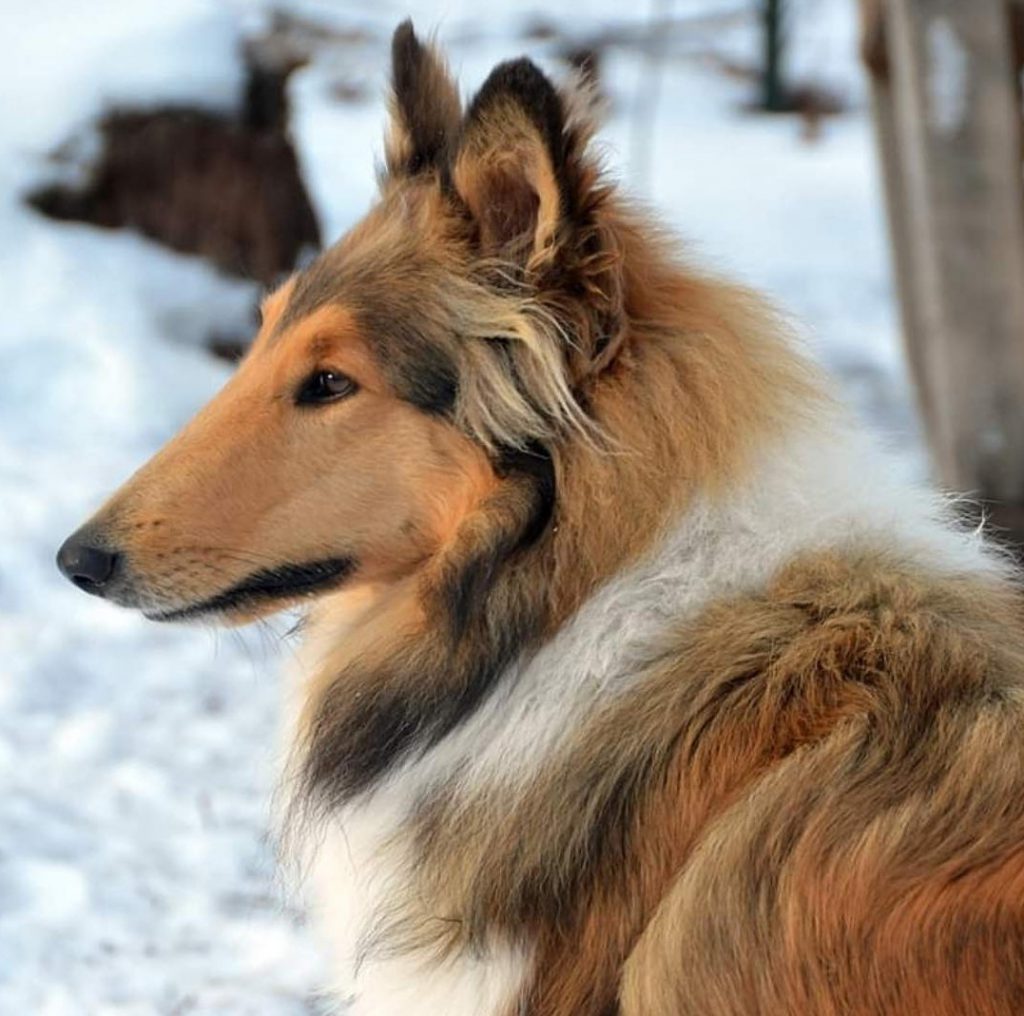
The best explanation I’ve yet read is from BetterBred Founder Natalie, and as a result we will share it again here!
Most breeders think of DNA as coming in two options- a good gene, or a mutant gene – like it is in many DNA tests. In fact, there are many genes or (in this case) markers that come in a great many variations – like a t-shirt that is available in different colors. The more variants there are, the more information we have about population genetics. In more inbred breeds, there are fewer variants for each marker. So an inbred breed might have only a few colors available in t-shirts, whereas a diverse breed will have many colors of t-shirts. Apart from the relatively small number of genes that make up specific, visible breed traits, the rest of the gene pool is generally healthier when there’s lots of variation.
Unfortunately when breeders select too strictly for too long for very specific traits, there can be an unintended loss of variation in the parts of the DNA that thrive with more variation. A good way to assess whether that good variation has been impacted is using the markers found in the VGL canine diversity test. Because they are considered neutral – or not associated with any specific known trait – they are great for assessing “kinship, population structure or genetic diversity loss.” In breeds with ample diversity, there will be lots of variations for each marker (lots of colors in the t-shirt drawer).
But what if you have a breed without much variation? Well, this happens, and can happen quite often. In this case the best thing breeders can do is try to make sure the variants that are in the breed are well distributed – so there are plenty of all of them in the breed. Imagine a t-shirt drawer with lots and lots of red t-shirts and only one blue one and one green one. If you lose one of the red ones, it doesn’t change much about the t-shirt drawer – there are lots of other red ones. But if you lose either the blue or green one, the variation is seriously diminished. If, on the other hand a third of the shirts are red, and a third are green and a third are blue, then it’s a lot harder to lose the existing variation in the drawer, even if you lose one once in a while and even though there are only 3 colors.
The Scottish Collie’s biodiversity
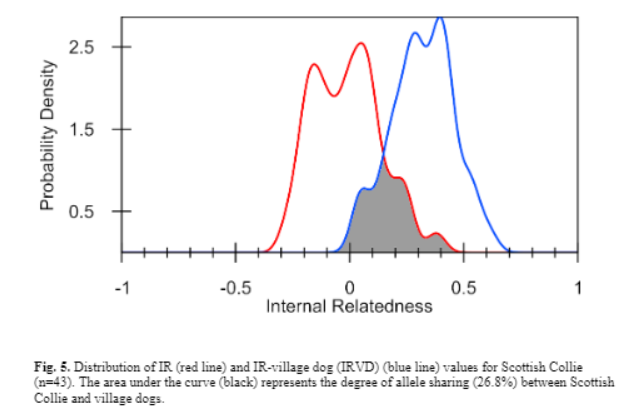
Another use of an individual’s inbreeding measure (IR value): we can look at the inbreeding level of all individuals in the breed in aggregate – meaning the whole breed together. When a breed was created with very few founders, or when it has had genetic bottlenecks at some point after founding, whether from breeding practices or world events, there can be very little biodiversity left within the breed. By adjusting inbreeding values in comparison to the data from randomly breeding village dogs (often considered the “ideal” comparison), researchers can estimate the remaining biodiversity of a modern breed compared to the original diversity that once existed in dogs prior to breed formation.
So when this investigation was done, what did Dr. Pedersen see?
The IRVD curve for the Scottish Collie tested was shifted to the right of the IR curve, and the area of overlap was 26.8% (Fig. 5). This figure is comparable to the 39.7% of retained genetic diversity calculated using a somewhat different population, i.e., all canids ever tested at the VGL (Tables 1, 2). This level of retained village dog genetic diversity is lower than the 60% or so retained diversity observed in the Miniature/Toy Poodle or 54% in Labrador Retriever, but much higher than the 23% for Irish Wolfhound, 15% in Doberman Pinschers and 7% in Swedish Vallhund.
Dr. Niels Pedersen 2019
This assessment indicates there is very little biodiversity in this breed, but let’s look at the data another way.

As mentioned in the quote above, another way to estimate the loss of biodiversity within a breed is to look at the average number of alleles found at each tested locus, and compare those to all the canine breeds thus far tested at UC Davis VGL. When looking at the number of alleles found, we consider two things: the average number of alleles found at each locus (Na = average alleles,) and the average number of alleles per locus that are effectively contributing to the population (Ne = effective alleles). Going back to the t-shirt analogy above, say we have 10 t-shirts…. 8 of them are red and one is green and one is blue. The total number of shirt colors is 3, however the majority color is red, therefore our “effective” t-shirt color would be only one.
So, by looking at these numbers, what do we find out about this population?
The average number of known alleles [in all dogs] for these 33 autosomal STR loci is 15.4, while the average number of alleles per locus (Na) for Scottish collie was 6.12 (Table 2). Therefore, the 43 Scottish Collie possessed only 6.12/15.4= 39.7% of known canid diversity for these markers. In other words, over 60% of known canid genetic diversity at these 33 loci has been lost up to this point in time. The amount of retained genetic diversity is higher than the Swedish Vallhund (31.9%); similar to the Flat Coated Retriever (38.6%), Irish Red and White setter (34.8%) and Magyar Agar (40.4%); but lower than popular breeds such as the Golden Retriever (54.5%), Toy Poodle (55.6%) and Standard Poodle (58%).
Dr. Niels Pedersen 2019
The estimate of remaining biodiversity left after breed formation using this method is 39.7%.
Additionally, Dr. Pedersen discovered that there is more diversity within the breed than is being effectively used, by finding that the effective alleles (Ne) were only 2.76, while the average alleles per locus (Na) were 6.12.. What do you do in the case of having diversity not contributing to the breed effectively? You identify individuals who may have unusual genetics for the population, and work to preserve those genetics and redistribute them in the population at large.
To add to the study, Dr. Pedersen tested 55 classic AKC or CKC registered Collies. When the results of the Scottish Collies tested were compared to the 55 tested Collies, the Scottish Collies were found to have much more biodiversity than the Collies.

When comparing the two, Dr. Pederen had this to say about the state of the Collie breed versus the Scottish Collie:
A standard genetic assessment was made on 55 conformation Collie for the purpose of breed comparison (Table 3). The Scottish Collie were more genetically diverse than Collie (Na = 6.12 vs 5.33) and had higher observed heterozygosity (Ho = 0.59 vs. 0.44). The average effective alleles per locus was higher (Ne = 2.76) in Scottish Collie than Collie (Ne = 2.12). The Scottish Collie were 2.2% more heterozygous (more outbred) than expected for a random breeding population (F = -0.022), while the Collie were 9% less heterozygous (more inbred) than expected (F = 0.09).
Dr. Niels Pedersen 2019
In summary, the Collie has retained much less biodiversity than the Scottish Collie, and is more inbred than the Scottish Collie.
These findings may change as more dogs are tested, and it is imperative for conscientious breeders to find and preserve any as yet unseen diversity in the breed. They can accomplish that first by testing as many dogs as possible, and keeping a keen eye out for healthy unusual or long isolated lines where perhaps there may be unrecorded genetic variation.
Genetic bottleneck evidence
Based on the analysis of the markers from the report, there appear to be certain alleles that are over-represented at each tested marker. This lends some evidence that there is a potential genetic bottleneck in the breed and breeders will need to work to maintain the biodiversity that remains.
Allele and allele frequencies at each locus indicates that a great deal of inbreeding has gone into the evolution of this group of 43 dogs. One to three alleles at each locus are found in 70-98% of individuals and 94% of the dogs shared the same allele (95) at the LE1004 locus. The average number of known alleles for these 33 autosomal STR loci is 15.4, while the average number of alleles per locus (Na) for Scottish Collie was 6.12 (Table 2).
Dr. Niels Pedersen 2019
Breed relationships
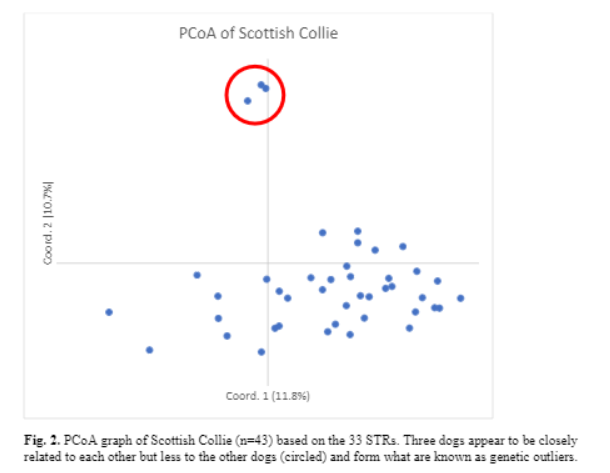
Another use of the data from the VGL canine diversity test is to see how the individuals within the population fit in relation to one another. What do we see when we look at this analysis, called the PCoA graph?
Forty of the 43 Scottish Collies formed a single population (i.e., breed) in PCoA (Fig. 1). However, three individuals were outliers from the main population, of sufficient distance to constitute a distinct “variety” of the breed or outcrosses with more distantly related dogs.
Dr. Niels Pedersen 2019
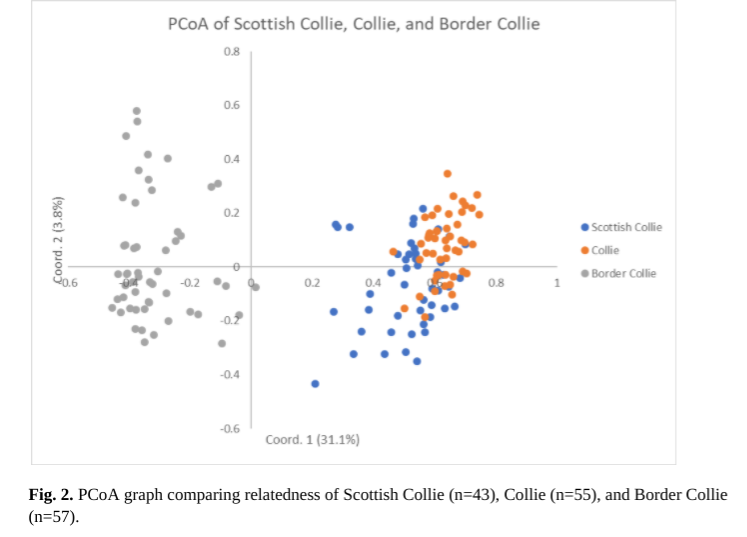
What about when we compare the Scottish Collie with Collies AND Border Collies?
The Scottish Collie and Collie were starting to differentiate into genetically distinct populations (i.e., subpopulations) – more like North American and European Italian Greyhounds or performance and conformation types of Golden Retrievers, but not yet to the level of varieties, such as seen with American and Japanese Akita, or Black and Pepper and Salt Giant Schnauzers. The Border Collies were genetically distinct from the Scottish Collie and Collie and manifested a surprising degree of genetic diversity between individuals, similar to Labrador and Golden Retrievers.
Dr. Niels Pedersen 2019
The immune system
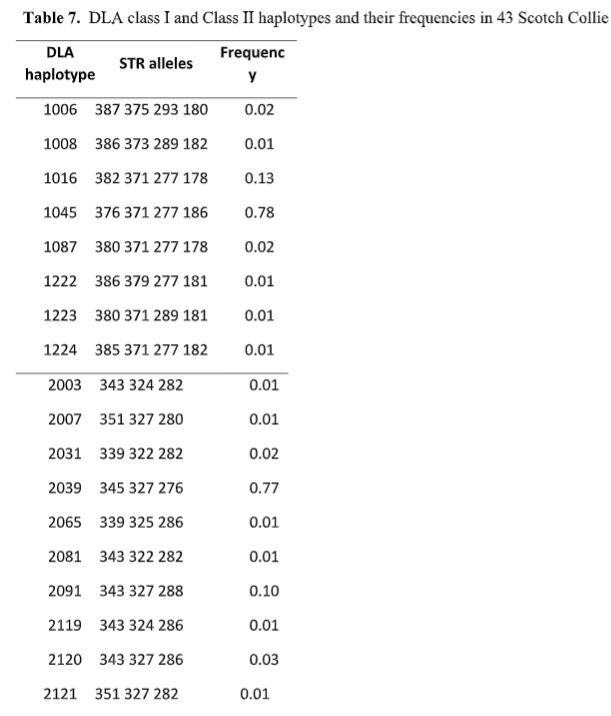
The UC Davis VGL canine diversity test can individually identify more regions of the DLA than any other test available today. The DLA, called Dog Leukocyte Antigen, is the region of the DNA that codes for the immune system in the dog. There are three regions, Class I, Class II and Class III. This test identifies both Class I and II haplotypes (a haplotype is a tightly linked group of genes within an organism that is inherited as a group from a single parent). To learn more about the DLA, read here.
The 43 Scottish Collies in this study possessed 8 DLA class I and 10 DLA class II haplotypes (Table 7). Three minor class I (1222-1224)) and three minor class II (2119-2121) are unique to the breed, to date, and the rest shared with a number of other breeds (Table 9). One class I (1045) and one class II (2039) haplotypes occurred in 77-78% of the dogs tested, while another class I (1016) and class II (2091) haplotype were observed in 10-13% of dogs. Collectively, these high incidence haplotypes were in strong linkage disequilibrium, forming larger 1045/2039 and 1016/2091 haplotypes and were found collectively in almost 90% of the 43 Scottish Collies tested. All of the remaining haplotypes occurred at incidences ranging from 1-3%.
Genetic diversity within the DLA region can also be compared between populations and breeds. The existing DLA class I and II haplotypes in Scottish Collie make up 8/205=3.9% and 10/112= 8.9%, respectively, of DLA haplotypes currently identified by the VGL. The numbers of DLA class I (n=8) and II (n=10) haplotypes found in Scottish Collie were higher than the Swedish Vallhund (6/4) and Shiloh shepherd (7/6); somewhat lower than Giant Schnauzer (14/15), Samoyed (13/12) and Shiba Inu (16/15); and much lower than Golden Retriever (26/23) and Miniature Poodle (33/ 23).
Dr. Niels Pedersen 2019
But what about these DLA haplotypes in comparison to the tested Collies? From Dr. Pedersen’s report:
DLA class I and II haplotypes found in Scottish Collie (Table 7) were compared with the haplotypes found in 49 conformation class Collies (Table 8). Only two DLA class I and three class II haplotypes were identified in these 49 Collies (Table 8). DLA class I 1045 and DLA class II 2097 haplotypes were in linkage disequilibrium forming an extended 1045/2039 haplotype that was found in 95% of the Collies tested. This same DLA class I/II haplotype was found in only 14.7% of Scottish Collie (Table 7).
Dr. Niels Pedersen 2019
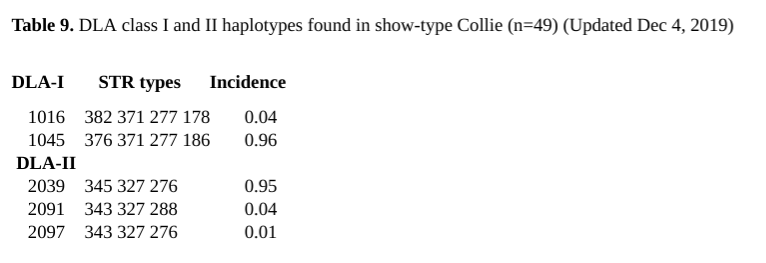
Due to the overwhelming over-representation of 1-2 DLA haplotypes in this breed, breeders should take some caution to make sure that the less well represented DLA haplotypes are not lost to genetic drift from this breed. The Scottish Collie Preservation Society has seemed to indeed to preserve DLA haplotypes that do not remain in the Collies.
Conclusions
The following conclusions from Dr. Pedersen sum up the findings from the 43 tested Scottish Collies tested thus far.
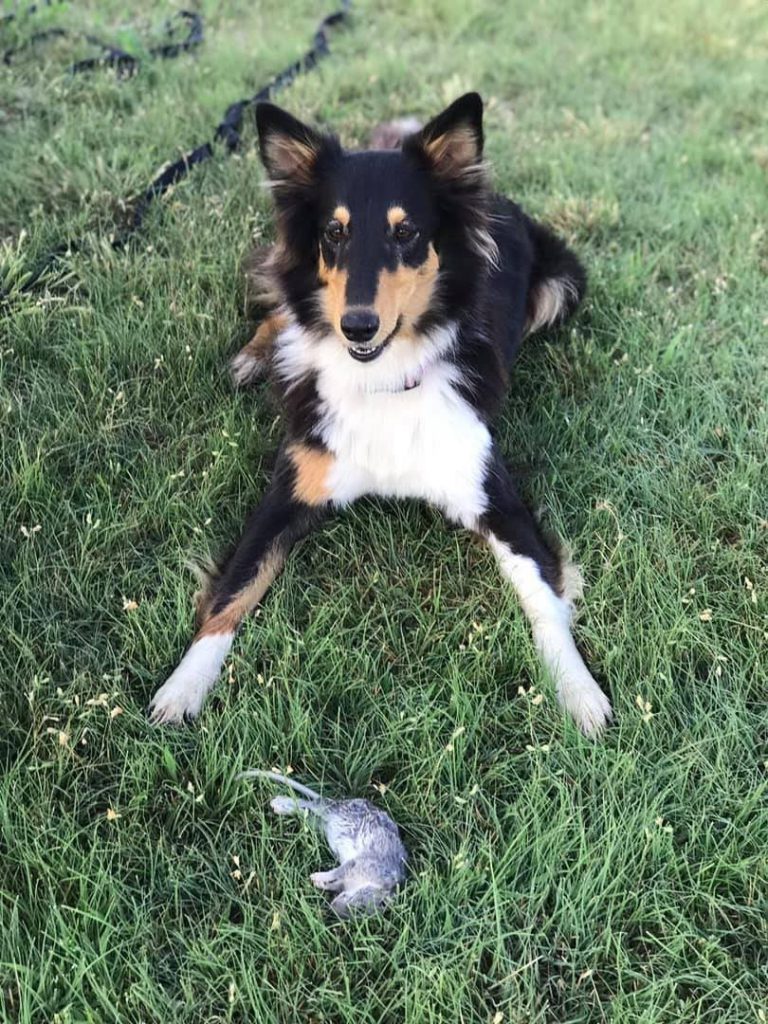
The 43 dogs that were studied herein are being evaluated as potential foundation stock for the modern restoration of the original farm-type Collie of Scotland. Forty of these 43 dogs were closely related based on the 33 autosomal STR markers and 7 DLA class I and II associated STRs. This particular group of dogs was also closely related to the conformation-type Collie based on strong sharing of two major DLA class I /II haplotypes. This relationship occurred at the variety rather than breed level. However, this relationship was opposite of what was
expected. The 43 Scottish Collie were more genetically diverse than the Collies and possessed a number of minor DLA haplotypes not found in the Collie. There are two differing explanations for this occurrence: 1) The 43 Scottish Collies were indeed representatives of a somewhat genetically diverse population of original farm-type Collie that still exists, and that contemporary Collie have evolved by more severe inbreeding into a small subpopulation of this population; or 2) that the 43 Scottish Collies contained a number of outcrossed and outcross/backcrossed dogs that were brought into the breed over the last decades as a surreptitious attempt to counter the
severe inbreeding perceived by some breeders. Evidence for the latter scenario came from three of the 43 dogs that were genetically outliers and presumably close outcrosses. Regardless, the 43 dogs in this study met the requirements of the new standard. However, closing the new registry with this type of dog would limit genetic diversity in the breed from the onset, and it might be 21 wise to consider including a degree of outcrossing with phenotypically similar, but genotypically
diverse and distinct breeds. The Border Collie meets those requirements as shown by the PCoA comparisons in Figure 2. Indeed, there are some individual Border Collies and Scottish Collies that appear to be more closely related to each other in the four-breed comparison in Figure 3.
The dominant objective of contemporary Scottish Collie breeders is to stay as close to pure Collies as possible, while preserving the working instinct, size and conformation of the classic farm Collie. “[The SCPS] intends to return the Scottish Collie to its original form, health, and vigor, with form fitted to its function of sheepherding by means of careful breeding, which provides for genetic diversity and selection of genetically-tested dogs and bitches resembling the dogs described in the earliest Standards of the breed [4].” This is a viable approach if the desired phenotypic traits still exist in an overt or hidden form among a sub-population of modern registered Collie or can be obtained through outcrossing. This goal is in line with statements
from some prominent breeders,“We are trying to restore the old fashioned Scotch Collies, it is a desperate situation but I believe this battle is not lost, we can take back genetic material from various sources where it has gone in past decades [18].”….
If there is evidence of too little genetic variability in the final selection of founders, some outcrossing may be considered in the future [18].
Dr. Niels Pedersen 2019
Outcrossing, if contemplated as the best way to increase genetic diversity, is not as simple as it might seem but fortunately facilitated by modern DNA testing. The first, and most important thing, is that the added diversity must not mimic existing diversity, nor can new genotypes replace existing genotypes. However, the linkage of genotypic and phenotypic traits may make this more difficult. The same phenotypes in other breeds may or may not add as much to genotypic diversity as desired. Secondly, it is important that heritable disorders not be introduced into the breed through the outcrosses. This will also require extensive DNA screening, although not all heritable disorders have identifiable genotypes. Genetic diversity brought in by outcrossing has to be rapidly and widely distributed among existing dogs.
The decision will remain with the Scottish Collie Preservation Society and other such efforts to decide what to do with their data and whether the existing biodiversity they have secured from the remnants of the original Scottish Collie is sufficient. In the meantime, BetterBred’s breed management tools will help them effectively maintain this biodiversity. This can be accomplished by breeding for dogs that are less related to other dogs in the database, dogs that have genetics that are not well represented in the population as well as selecting for litters whose parents will be as unrelated as is reasonable (and therefore reducing inbreeding in offspring).
A striking observation was the comparison of the Scottish Collies with that of the mainstream show Collies – this comparison showed that the Collie today has much less biodiversity than the Scottish Collie, as well as much less biodiversity in the DLA. It will be interesting to see how this trend develops as more Collies are tested.
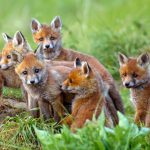 Previous Post
Previous Post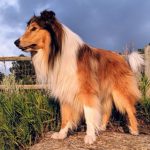 Next Post
Next Post


